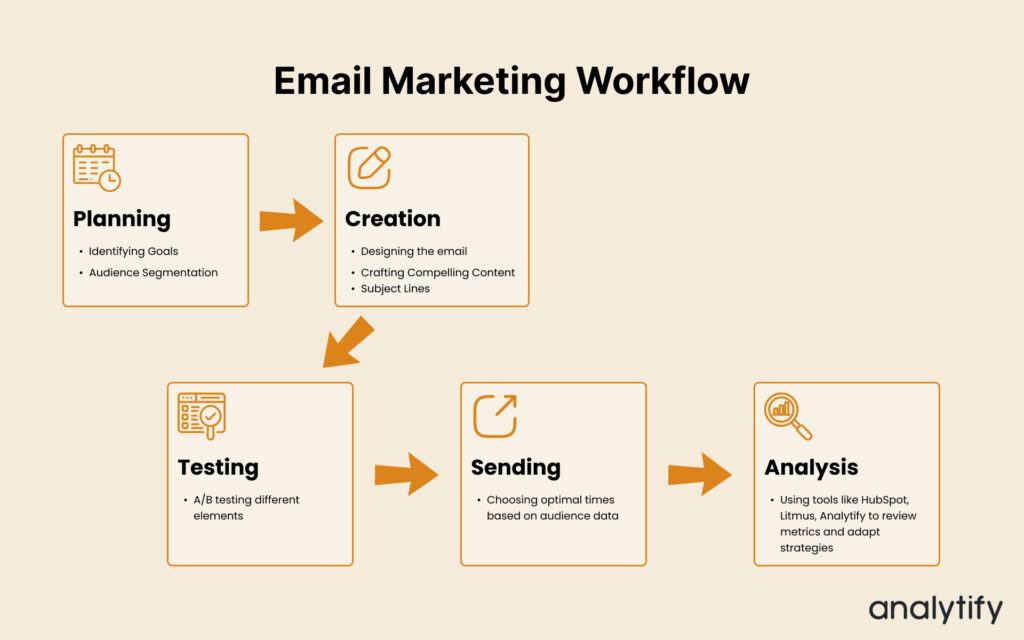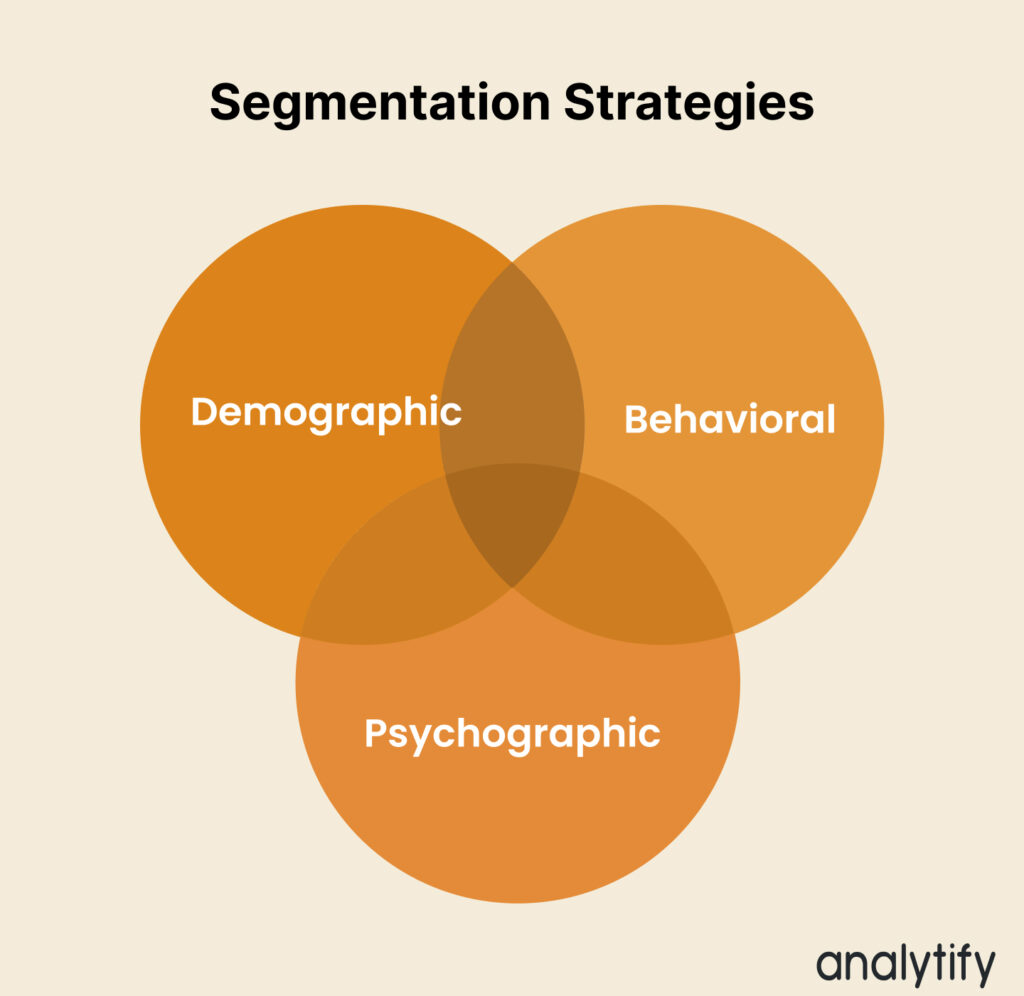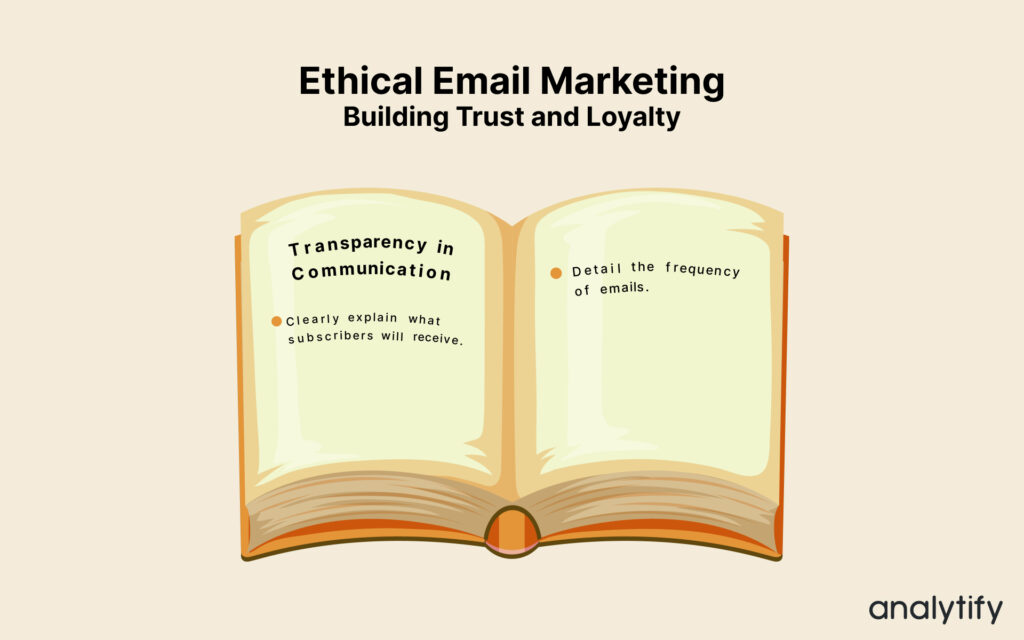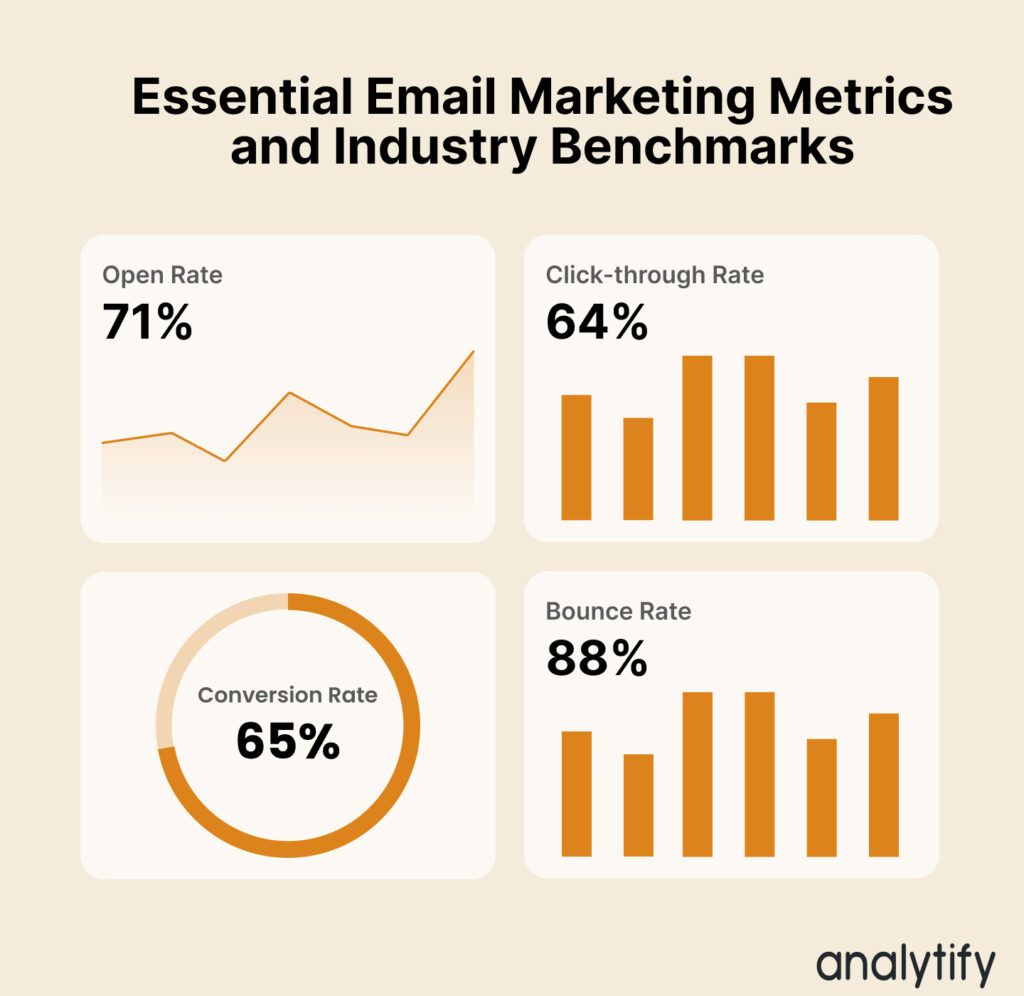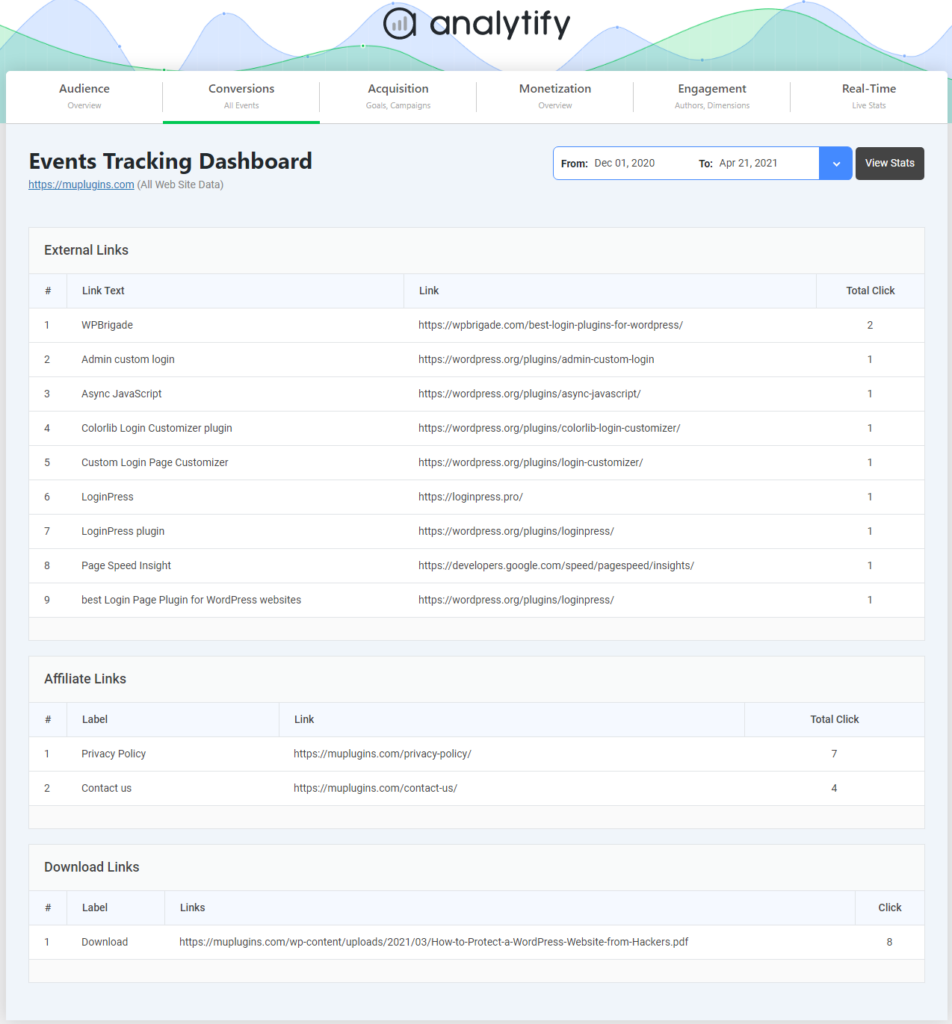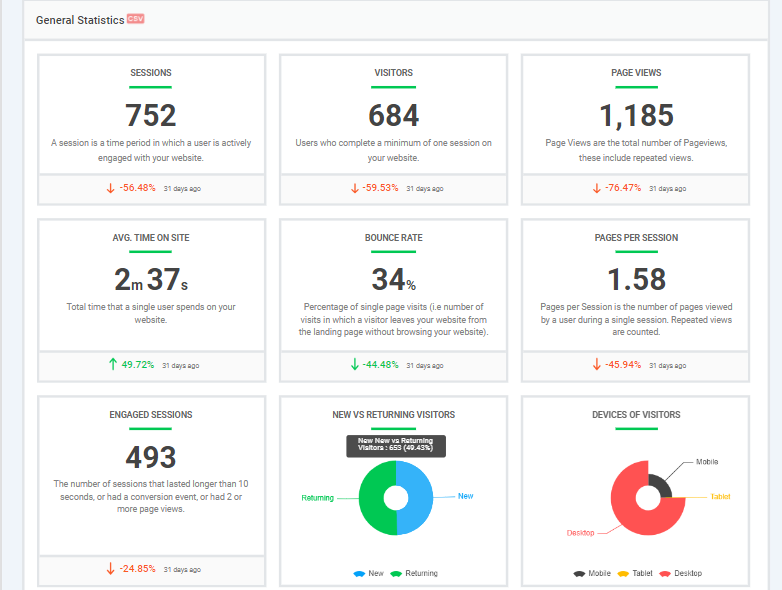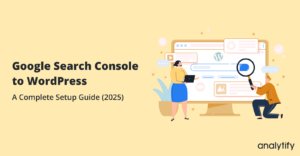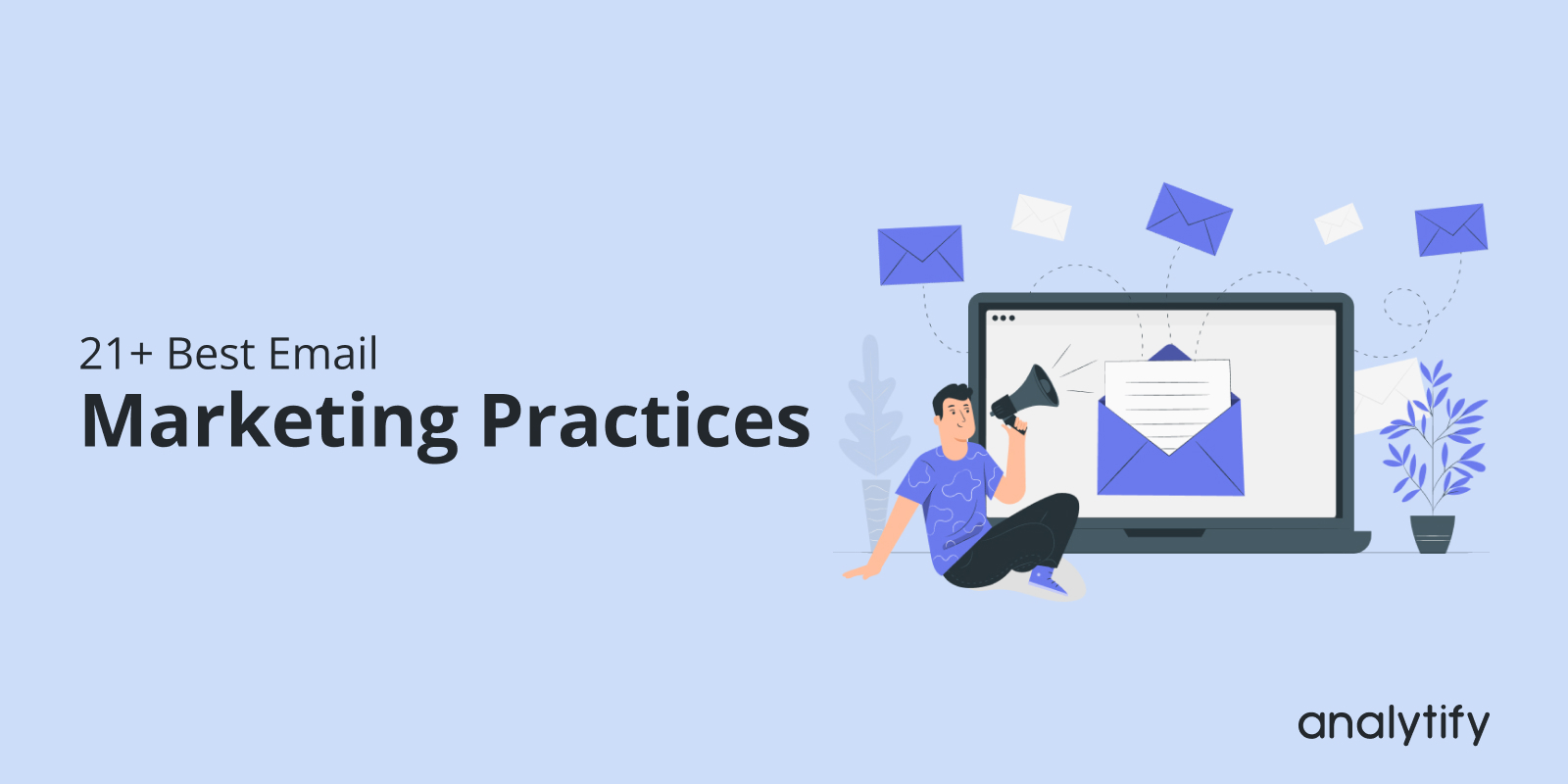
21+ Email Marketing Best Practices 2025
Do you want to know all about the email marketing best practices in 2025? If yes, you’re in the right place.
Email marketing isn’t just about sending out weekly newsletters anymore. It’s about creating meaningful connections and ensuring your messages hit the mark every single time.
It’s time to sharpen our strategies and make sure we’re ahead of the curve. Whether you’re a small business owner, a marketing guru, or just starting out, understanding the best practices for email marketing can transform your approach and results.
In this guide, we’ll discuss the best email marketing best practices in 2025. We’ll explore everything from crafting irresistible subject lines to mastering the art of timing and personalizing your email marketing campaigns.
Let’s get started!
Email Marketing Best Practices (TOC):
Benefits of Email Marketing
Why even bother with email marketing? Well, it’s simple. Email marketing continues to be one of the most effective ways to reach your audience directly and personally. Here’s why it’s still a game-changer:
- High ROI: For every dollar you spend on email marketing best practices, expect an average return of $42. That’s a huge bang for your buck!
- Customer Retention: It’s not just about finding new customers; it’s also about keeping the ones you have. Regular, relevant emails keep your brand at the top of your customers’ minds.
- Personalization: With advancements in technology, emails can now be highly personalized. It isn’t just about adding a first name; it’s about tailoring content based on customer behavior and preferences.
By investing in the best email marketing practices, you’re setting your business up for more engagement, better relationships, and higher sales.
26 Best Practices for Email Marketing in 2025
Let’s move on to best practices for email marketing next.
Setting the Foundation
1. Understanding Your Audience
- Knowing who you communicate with is the cornerstone of effective email marketing best practices. Use segmentation tools to divide your audience based on their interests, behaviors, and demographics. This detailed understanding allows you to craft messages that resonate deeply with your audience, improving engagement and conversion rates.
- Email marketing analytics tools track important metrics such as open rates, click-through rates, and conversion rates, offering insights into how your emails are performing. They also allow for advanced segmentation and persona development, enabling you to send targeted, relevant content.
Here’s a table that includes both the pricing options and key features of the suggested email marketing analytics tool.
| Email Marketing Tool | Pricing Options | Key Features |
| Mailchimp | Free plan available | – Comprehensive analytics, Advanced segmentation, Automation and personalization options, Integrated CRM features |
| Campaign Monitor | Paid only | – Beautifully designed templates, Detailed reporting, Automation features, Transactional Email capabilities |
| Constant Contact | Paid only | – Intuitive interface, Social media integration, Event management tools, Extensive reporting and analytics |
| GetResponse | Free trial, then paid | – Email automation, A/B testing, Landing pages, Webinars, Conversion funnel features |
| HubSpot Email Marketing | Free plan available | – Part of a larger marketing platform, CRM integration, Email personalization, Detailed analytics, Marketing automation |
Regularly updating your strategies based on these insights helps maintain the effectiveness of your campaigns.
While the tools listed above are great for email marketing analytics, if you’re using WordPress and want to track your website’s overall performance, including how your email traffic contributes to your site metrics, Analytify might be the perfect addition.
Analytify is designed to make Google Analytics simple for WordPress users. It provides a user-friendly dashboard directly in your WordPress admin area, showing you easy-to-understand data about your website’s traffic, social media performance, marketing campaign efforts, and more.
2. Optimizing Email Design for Different Devices
In today’s world, people check their email on a variety of devices, so it’s important that your emails look good everywhere. The design should automatically adjust for optimal viewing whether someone opens your email on a smartphone, tablet, or computer. This is one of the best practices of email marketing, ensuring that your message is effectively communicated, no matter the device.
Here’s how to optimize your email designs for different devices effectively:
3. Use Responsive Design Templates
Start with templates that are designed to adapt to any screen size. Most email marketing platforms provide a range of responsive templates. These templates automatically adjust the layout and size of your content based on the viewing device.
Keep It Simple: Simplify your email design. Complex designs with multiple columns or excessive elements can break easily on smaller screens. A single-column layout works best as it scales down seamlessly from desktop to mobile.
4. Consider Font Sizes
The text in your email should be large enough to be readable on small screens without zooming. A general rule is to keep the body text at least 16px and headlines more prominent, around 22px to 24px. It ensures readability across all devices.
4. Test Your Email Across Devices
Before sending an email, test how it looks on different devices. Tools like Litmus or Email on Acid can show you how your email will appear on various devices and email clients. This step will help avoid display issues that could impact the reader’s experience.
Preview and Adjust: Always preview your email on multiple devices and make necessary adjustments. What looks good on a desktop might not translate well to a smaller screen. Adjustments might include increasing line spacing for better readability or tweaking the layout to ensure key information is visible without scrolling.
5. Optimize Images
Ensure that images are high quality and not too heavy. Large images can slow down page loading times, especially on mobile devices. Use appropriate image sizes that load quickly and look good on both high and low-resolution screens.
6. Touchable Calls-to-Action
On mobile devices, your call-to-action (CTA) buttons need to be easy to tap. Ensure they are a comfortable size (at least 44×44 pixels as recommended by Apple’s guidelines) and have ample space around them to avoid accidental clicks.
These foundational practices are essential for setting up a holistic email marketing strategy that captures and keeps your audience’s attention. By understanding who your audience is and ensuring your emails are beautifully designed on any device, you’re building a solid base for all your email marketing efforts.
7. Add an Email Signature
Your email signature is more than just a sign-off – it’s a valuable piece of real estate for building trust and showcasing your brand’s personality. A well-designed signature adds professionalism to your messages and helps reinforce your identity in every interaction. Include your name, title, company logo, social links, and a strong CTA when possible. You can easily create a custom, aesthetic email signature using tools like Newoldstamp, which offer free templates tailored to your industry.
Content Strategies
8. The Art of the Subject Line
- The first thing your recipients see isn’t your beautifully designed email; it’s the subject line. Making a strong first impression here is necessary.
- Keep your subject line short. It should be 50 characters or less to ensure that your full subject line is visible on most devices.
- Use compelling, curiosity-sparking phrases that promise value.
- Experiment with emojis, questions, or teasers to see what drives the best open rates. This is one of the best practices for email marketing that can significantly impact your campaign’s success.
9. Personalization Techniques
- Personalization is more than just sprinkling personal details like names into your emails. It involves tailoring the email content based on user behavior, such as past purchases or interactions with your site.
- For instance, sending a product recommendation based on previous purchases can make emails feel more individualized and relevant. This strategy enhances the effectiveness of email best practices, leading to higher engagement rates.
10. Content Relevance
- Always ensure the content you send out is relevant to the recipient. It could mean adjusting your messages according to where they are in the customer journey or their specific interests. Keep content fresh and aligned with their current needs, which can be tracked via engagement metrics or direct feedback. Staying relevant is a crucial aspect of best email marketing practices.
11. Interactive Emails
- Engage your audience more actively by incorporating interactive elements into your emails. They can include embedded polls, surveys, or even simple games. Interactive emails are more engaging and provide valuable feedback and data about your subscribers. Using such innovative content aligns with best practices in email marketing by boosting user engagement and gathering insights.
These content strategies are designed to enhance the effectiveness of your emails, ensuring all your emails are seen and acted upon.
Ready to explore the next set of practices focused on testing and timing?
Testing and Timing
12. A/B Testing Your Emails
- One of the best practices for email marketing is A/B testing. A/B testing allows you to send two variations of the same email to see which performs better. You must never settle on assumptions
Test different elements like subject lines, email content, or call-to-action buttons. This method helps refine your approach, ensuring you’re constantly improving and optimizing your email campaigns.
A/B Testing Tools
Sure! Here’s a table that outlines the A/B testing tools along with their key features and pricing options:
| Tool | Key Features | Pricing |
| Mailchimp | User-friendly interface, tests various elements like subject lines, content, send times, automatic winner sending | Free plan available; paid plans for more features |
| Campaign Monitor | Robust A/B testing up to 10 versions, automatic selection of winning campaign based on metrics | Paid service, pricing based on subscriber list size |
| Optimizely | Extensive testing capabilities across emails, websites, and apps, visual editing, behavioral targeting | Custom pricing depending on scale and needs |
| GetResponse | All-in-one platform with A/B testing for subject lines, content, images | 30-day free trial, paid plans vary by list size and features |
| HubSpot | Part of a comprehensive marketing hub, tests email elements, detailed analytics | Free tools available; advanced features in paid plans |
| Litmus | Focus on email design and testing, A/B testing functionality, integrates with other platforms | Premium service with different pricing tiers |
This table provides a quick overview of each tool’s capabilities and cost structure, helping you to decide which tool might be best suited for enhancing your email marketing efforts through effective A/B testing.
How to do A/B Testing?
Here’s how you can effectively implement A/B testing in your email campaigns:
- Choose One Variable to Test: Change only one element at a time to ensure accurate results. This could be the subject line, the call-to-action (CTA), the email layout, the images used, or even the send time. By isolating the variable, you can clearly understand its impact on the email’s performance.
- Define Your Goal: Determine what you’re testing for. Is it an open rate, click-through rate, or conversion rate? Setting a clear goal will help you understand which version of your email is more effective for achieving that specific objective.
- Segment Your Audience Randomly: Make sure the test groups are randomly selected and that they are similar in size and demographics. This ensures that external factors do not skew the results and that they apply to your broader audience.
- Test Simultaneously: Send both versions of your email simultaneously to avoid differences in time influencing the results. For example, sending one version in the morning and another in the evening could lead to misleading data due to differing email engagement patterns at these times.
- Use Significant Sample Sizes: The larger your test groups, the more reliable your data will be. If your email list is large enough, aim for a sample size that gives you statistically significant results, ensuring the data’s validity.
- Analyze the Results: After the test, analyze the data based on your goal. Look at the metrics that matter most to your test, whether those are open rates, click rates, or direct conversions from the email.
- Implement Learnings: Apply the insights from the A/B test to your broader email strategy. If one subject line significantly outperformed another, use a similar strategy in future emails. Continue to refine and test other elements based on ongoing results.
- Document and Repeat: Record all the tests you conduct and their outcomes. This documentation will help you build a knowledge base over time, guiding similar future tests and broader marketing strategies.
13. Determining Optimal Email Frequency
Finding the right balance in how often to send emails is a key component of email marketing best practices. Sending too many emails can overwhelm your subscribers and lead to higher unsubscribe rates while sending too few can cause your audience to forget about your brand.
Here’s how you can determine the optimal email frequency:
- Understand Your Audience’s Preferences: Consider your audience’s preferences, which can be observed from previous campaign data or direct feedback. Some segments may appreciate more frequent updates, while others might prefer less frequent communication.
- Monitor Engagement Metrics: Pay close attention to each campaign’s open rates, click-through rates, and unsubscribe rates. A drop in engagement or increased unsubscribes can indicate that you’re sending emails too frequently.
- Test Different Frequencies: Implement A/B testing by dividing your audience into groups and varying the frequency of emails each group receives. This method can provide actionable data on how different frequencies impact engagement.
- Segment Your List: Not everyone in your audience wants to hear from you with the same frequency. Use segmentation to adjust your email frequency based on user behavior and interaction level. For example, active users might receive more frequent communications than less engaged subscribers.
14. Best Timing for Email Sends
Timing can greatly influence the success of your email campaigns. The optimal send time can vary based on your audience’s habits and time zones. Use analytics to track when your emails are most likely to be opened and read. Testing different times and days of the week can lead to surprising increases in engagement, making it a critical component of best email marketing practices.
- Best Days to Send Emails:
Tuesday, Wednesday, and Thursday are typically the best days to send emails. Research has shown that midweek days generally have higher engagement rates than Mondays and Fridays (CoSchedule).
- Best Times to Send Emails:
Morning Hours (10 AM): This time is often recommended because it aligns with the start of the workday for many people, potentially catching them as they check their email at the beginning of their day.
Early Afternoon (1 PM): This time targets the post-lunch slump, where recipients might be looking for distractions.
Late Afternoon (around 4 PM): Catching people before they finish their workday can also be effective.
Source (HubSpot).
Automation and Integration
15. Automation Strategies
- Automation is a powerful tool in email marketing, allowing for timely and relevant communication without constant manual effort.
- Set up automated email sequences for welcome emails, birthday offers, or follow-up messages after a purchase.
- These automated emails can significantly enhance the user experience and ensure consistent engagement. Utilizing automation is a crucial aspect of email marketing best practices.
16. Segmentation and Targeted Campaigns
Use segmentation to increase the relevance of your automated emails.
Divide your email list into groups based on demographics, behavior, or purchase history. This allows you to tailor your messaging to meet each segment’s specific needs and interests, which can significantly improve the effectiveness of your campaigns.
Imagine you run an online clothing store that caters to a wide range of customers. To improve the relevance of your email marketing, you decide to segment your email list and create targeted campaigns based on specific criteria.
How to Do Segmentation?
Step 1: Data Collection
You start by collecting data from your customers through various means:
- Purchase history: What items have they bought? What categories do they shop in most frequently?
- Demographics: Information like age, gender, and location.
- Behavioral data: How often do they visit your website? What products do they view but not purchase?
Step 2: Creating Segments
Using the collected data, you create several distinct segments:
- Segment A: Young Adults (Ages 18-25) – This group frequently buys casual wear and trendy items.
- Segment B: Middle-Aged Professionals (Ages 26-45) – This group tends to purchase formal wear and high-quality, classic pieces.
- Segment C: Return Customers – Customers who have made multiple purchases in the past year.
Step 3: Crafting Targeted Campaigns
For each segment, you craft emails tailored to their interests and behaviors:
- Campaign for Segment A: Trend Alerts
- Content: Latest trends, new arrivals in the casual wear category, and a special discount on trendy items.
- Call to Action: “Shop the trend before it’s gone!”
- Campaign for Segment B: Professional Wardrobe Essentials
- Content: Showcase of new arrivals in formal wear, style guides for professional settings, and exclusive offers on premium brands.
- Call to Action: “Elevate your professional look!”
- Campaign for Segment C: Loyalty Rewards
- Content: Thank you message for their loyalty, early access to sales, and an extra loyalty discount on their next purchase.
- Call to Action: “Enjoy your exclusive rewards!”
Step 4: Sending and Monitoring
You send out these targeted campaigns and monitor key metrics such as open rates, click-through rates, and conversion rates for each segment. This data will help refine your approach, understand what resonates with each group, and further tailor future communications.
Benefits
By segmenting your list and targeting your campaigns, you achieve several benefits:
- Increased Relevance: Each customer receives content more aligned with their interests and needs.
- Higher Engagement: Personalized content leads to higher open and click-through rates as customers are more likely to engage with content that appeals to them.
- Improved Conversion Rates: Tailored offers and products will likely lead to purchases.
This example illustrates how segmentation and targeted email campaigns can directly address the preferences of different customer groups, making your marketing efforts more effective and efficient. By recognizing and acting on the distinct characteristics of each segment, you ensure that your marketing messages hit the mark every time.
17. Integration with Other Marketing Channels
Your email marketing should not exist in a vacuum. Integrate it with other channels, such as social media, your website, or even offline campaigns, to create a cohesive and unified marketing strategy.
For example, use social media to gather new email subscribers or promote exclusive email content on your social platforms to drive cross-channel engagement. This integration is part of the broader email marketing practices and helps amplify your overall marketing efforts.
18. Offer an Incentive to Sign Up
Encourage more sign-ups by offering something valuable in exchange for email addresses. This could be a discount code, an exclusive ebook, or an introductory video. Use Analytify to track which types of incentives generate the most sign-ups and engagement, allowing you to optimize future offers based on solid data.
Experiment with different types of lead magnets to see what resonates best with your audience. For instance, if you’re a fitness coach, your lead magnets could range from free workout plans, nutritional guides, to discount codes for your training sessions.
19. Include Different Sign-Up Forms
Enhance the visibility and accessibility of your sign-up forms by placing them in various strategic locations across your website.
Use Analytify to analyze which locations and form designs yield the best conversion rates, enabling you to make data-driven adjustments for improved performance.
Compliance and Ethics
20. Understanding GDPR and Other Regulations
- Staying compliant with regulations like the General Data Protection Regulation (GDPR) is a legal necessity and a way to build trust with your audience.
- Ensure that your email marketing practices respect privacy laws by obtaining consent before sending emails, providing clear unsubscribe options, and managing data securely. Familiarizing yourself with these rules is important for following the best practices in email marketing in 2025.
21. Ethical Email Marketing
- Ethics in email marketing go beyond compliance. It’s about respecting your subscribers and treating them fairly.
- It means being transparent about what they can expect from your emails, avoiding misleading content, and being straightforward about the nature of your promotions. Ethical practices ensure long-term trust and loyalty, which are key to sustaining the effectiveness of best practices email marketing.
Advanced Analytics and Optimization
22. Key Metrics to Track
- To effectively measure the success of your email campaigns, you need to focus on key performance indicators such as open rates, click-through rates, conversion rates, and unsubscribe rates.
- Tracking these metrics provides insight into what’s working and what’s not, allowing for data-driven decisions. Utilizing tools to analyze these metrics is an essential part of best email marketing practices.
23. Email Deliverability Best Practices
- Ensuring your emails actually reach your subscribers’ inboxes is important. To improve deliverability, avoid spam triggers in your content, maintain a healthy sender reputation, and regularly clean your email list.
- Practices like these are fundamental to maintaining high deliverability, which is a cornerstone of effective email marketing best practices.
24. ROI Measurement and Improvement
Measuring the return on investment (ROI) from your email campaigns helps you understand the financial impact of your email marketing efforts. Analyze which campaigns generate the most revenue relative to cost and adjust your strategies accordingly.
Understanding and applying these advanced practices ensures your email campaigns are practical and economically advantageous. Ready to look at the future trends and innovations in the next section?
Future Trends and Innovations
25. AI and Email Marketing
- Artificial intelligence (AI) revolutionizes email marketing by enabling more personalized and efficient campaigns. AI can help automate content creation, predict the best sending times based on subscriber behavior, and personalize emails at an individual level.
- Embracing AI correctly as part of your email marketing best practices in 2025 can significantly enhance your campaign effectiveness and customer engagement.
26. Emerging Technologies in Email Marketing
Keep an eye on emerging technologies that could impact email marketing. Technologies like machine learning for better prediction models augmented reality for more immersive content, and blockchain for improved security and transparency are on the rise. Staying ahead of these technologies is essential for incorporating cutting-edge innovations into your email marketing best practices.
Use Analytify in your Email Marketing
Integrating Analytify into your email marketing strategy can significantly increase your ability to understand and act on your campaign analytics. (Read to install Analytify)
While Analytify is primarily known for its seamless integration with WordPress to provide straightforward Google Analytics data, it can also be an invaluable tool for gaining deeper insights into how your email campaigns affect website behavior.
How Analytify Enhances Email Marketing?
- Linking Email Campaigns to Site Traffic: Analytify can show you how recipients of your emails interact with your website. You can see which pages they visit after clicking through from an email, how long they stay, and what actions they take. This information is crucial for understanding the effectiveness of specific email campaigns in driving meaningful engagement.
- Conversion Tracking: Set up events in Google Analytics to track conversions that originate from your emails. Analytify makes these data points accessible directly within your WordPress dashboard, helping you see the direct impact of your emails on sales, sign-ups, or other key actions.
- User Behavior Insights: Gain insights into how different segments of your email list interact with your site. Analytify can help you understand which segments are most engaged and which may need more targeted content or offers to increase their activity.
- Enhanced Reporting: Use Analytify to create custom reports that show the performance of your email-driven traffic alongside other traffic sources. This holistic view allows for better strategic decisions and more fine-tuned targeting in your campaigns.
- Simplified Access: For WordPress users, having these analytics accessible directly on the dashboard simplifies the process of data analysis, making it easier to make informed decisions quickly without needing to navigate the complexities of Google Analytics.
Email Marketing FAQs
Q1: How often should I send emails to my subscribers?
The optimal frequency for sending emails varies depending on your industry and audience. Start with industry benchmarks and adjust based on subscriber feedback and engagement metrics. Remember, more isn’t always better; focus on sending valuable content rather than just increasing frequency.
Q2: What are the best ways to segment my email list?
Effective segmentation can be based on demographics, subscriber behavior, purchase history, or engagement levels. Use the data you collect from subscriber interactions and preferences to create segments that allow for more targeted and relevant email campaigns.
Q3: How can I improve the open rates of my emails?
To improve open rates, craft compelling subject lines that pique curiosity or offer immediate value. Also, ensure that your emails are optimized for all devices, send them at times when your audience is most likely to be checking their email and maintain a clean, engaged email list.
Q4: What metrics should I track to measure the success of my email marketing campaigns?
Key metrics to track include open, click-through, conversion, and unsubscribe rates. Additionally, consider monitoring the overall ROI of your campaigns by analyzing the revenue generated from each email relative to the cost of producing and sending it.
Q5: How can I ensure my emails don’t end up in the spam folder?
To avoid the spam folder, ensure your email content is relevant and engaging, and avoid spam trigger words like “free,” “guarantee,” or excessive use of exclamation points. Also, maintain a healthy sender reputation by keeping your email list clean and asking subscribers to whitelist your email address.
Q6: Can I use email marketing for lead generation?
Yes, email marketing can be a powerful tool for lead generation. Provide value through informative content, use effective calls-to-action, and offer lead magnets like eBooks, webinars, or free trials to encourage subscribers to share their information.
Q7: Is A/B testing really necessary for email marketing?
A/B testing is essential to optimize your emails and ensure they perform as well as possible. By testing different elements of your emails, you can learn what resonates best with your audience and make data-driven decisions that improve the effectiveness of your campaigns.
Q8: How does Analytify help with email marketing?
While Analytify is primarily a tool for analyzing web traffic via Google Analytics, it can help you understand how visitors from your email campaigns interact with your website. This insight allows you to measure the effectiveness of your emails in driving traffic and achieving specific conversion goals.
Conclusion
Incorporating the best practices for email marketing into your strategy is essential for success in 2025.
As we’ve explored, ensuring your email best practices are up to date can dramatically improve your communication’s effectiveness. It’s about respecting your audience, delivering valuable content, and continually refining your approach using data-driven insights.
Whether you’re just starting out or looking to enhance an existing campaign, the best email marketing practices provide a roadmap to more engaging, productive, and ethically sound interactions with your subscribers.
We hope this article helped you understand email marketing best practices in 2025.
However, you may also like to know How to Track Google Analytics Top Selling Products in 2025.
We’d love to hear from you about the best practices you were already using in your email marketing strategy. What are you going to try next?


